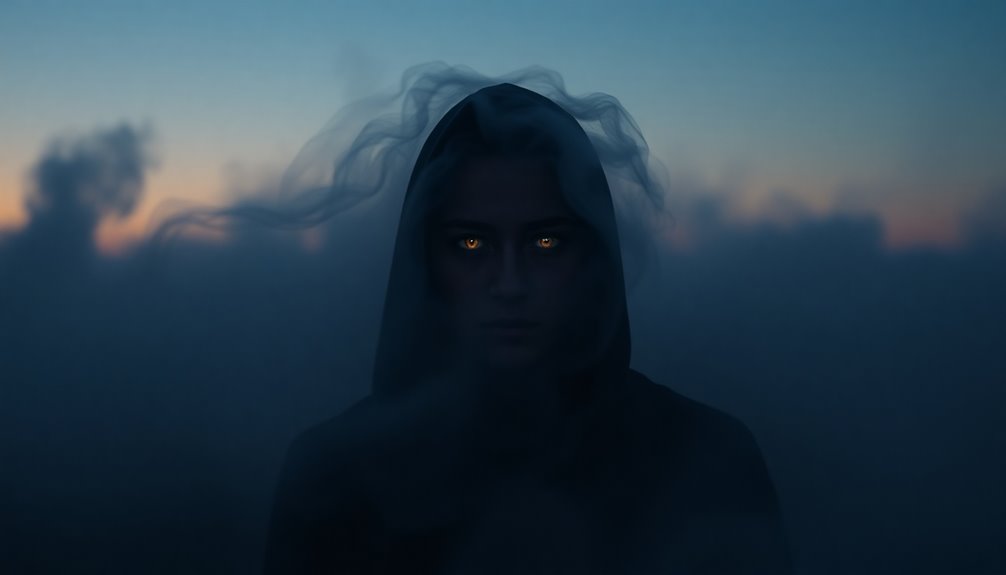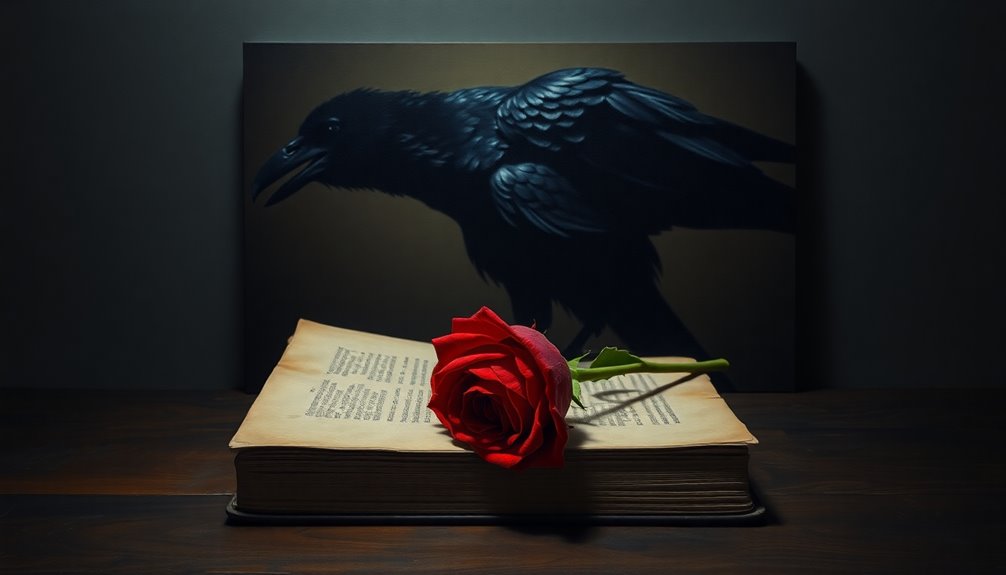The black owl's a potent symbol of wisdom and protection, connecting you to hidden truths and the supernatural. Rooted in mythology, it's associated with the goddess Athena and serves as a guide between life and the afterlife. Its haunting call often warns of misfortune, while its intelligence embodies insight and introspection. Culturally, many see black owls as guardians, revered for their role in folklore and spiritual beliefs. With their silent flight and exceptional hunting skills, they're masters of the night. Curious about more fascinating traits and their significance? There's much more to uncover about this mystical bird!
Key Takeaways
- The black owl symbolizes wisdom, guiding souls and offering hidden truths, particularly in mythology associated with the goddess Athena.
- In various cultures, the black owl is seen as a protective spirit and a harbinger of new beginnings, embodying insight and introspection.
- Known for its silent flight and keen hunting skills, the black owl effectively hunts at night, enhancing its role as a guardian of knowledge.
- Cultural beliefs link black owls to the afterlife, with their haunting calls serving as omens of death or misfortune, emphasizing their mystical nature.
- Conservation efforts are vital for protecting black owls from habitat loss and invasive species, ensuring their continued role as messengers of wisdom.
Symbolism and Mythology of the Black Owl
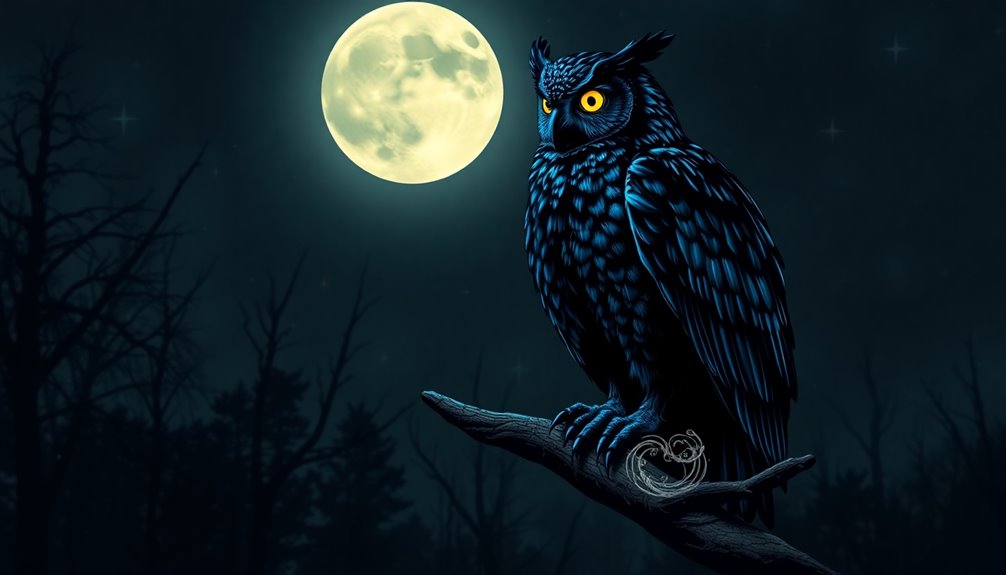
Exploring the symbolism and mythology of the black owl reveals a fascinating interplay of themes associated with wisdom, death, and the supernatural. The black owl's association with goddesses like Athena highlights its dual role as a guardian of wisdom and a symbol of death. Athena, the Greek goddess of wisdom, chose the owl as her familiar, representing the ability to see beyond mere appearances and discern hidden truths.
In various cultures, you'll find the black owl linked to the afterlife, guiding souls from one realm to another. Its haunting screech often serves as an omen, foretelling death or misfortune. Additionally, owls often symbolize shadow work, representing the exploration of the unconscious mind and personal growth.
Yet, this nocturnal creature isn't solely a harbinger of doom; it also embodies insight and introspection. The black owl's keen vision and silent flight symbolize the journey into the unconscious, illuminating hidden knowledge.
The contradictory nature of the black owl further enriches its symbolism. It can represent both victory and misfortune, depending on the context. As you delve into its mythology, you'll uncover a rich tapestry of meanings that invite you to explore the depths of wisdom and the mysteries of the unknown.
Cultural Significance Across Regions
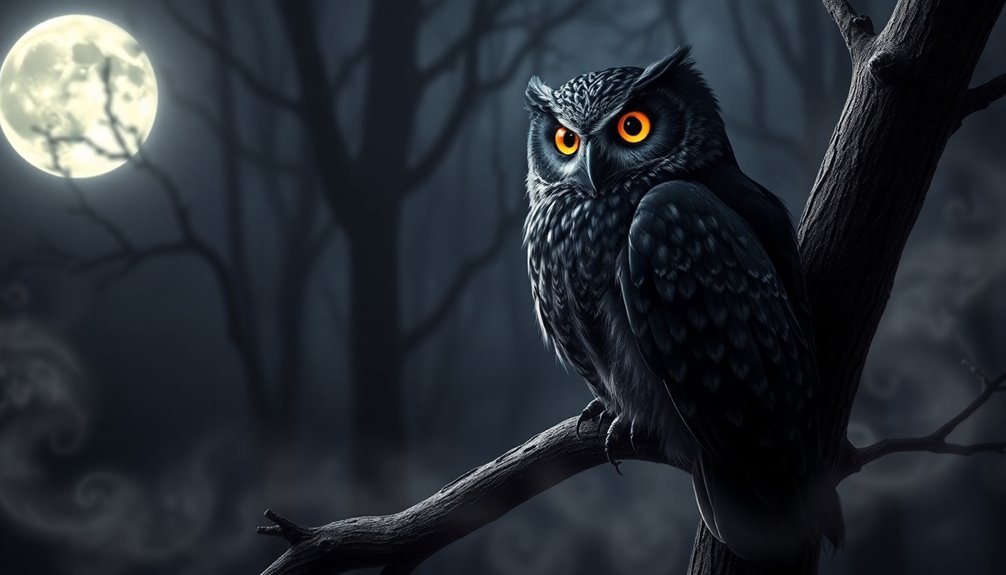
While the black owl's symbolism varies across cultures, its significance consistently intertwines themes of wisdom, protection, and the supernatural.
In ancient civilizations like Egypt and Greece, the owl represented guardianship of the underworld and was closely associated with deities like Athena, symbolizing intelligence and wealth. The Romans viewed the owl as a harbinger of death, yet still revered it in connection with Minerva.
In European folklore, particularly during the Middle Ages, the owl took on a more sinister role, often linked to witches and darkness. Its call was believed to predict death or misfortune, leading to practices aimed at warding off evil.
In Native American cultures, the black owl embodies wisdom and foresight, guiding warriors and serving as a protective spirit. Tribes like the Apache and Cree held deep respect for its symbolic power, viewing it as a messenger from the spirit world, often associated with the duality of Owls as both protectors and harbingers of death.
In modern times, you'll find that owl sightings often symbolize new beginnings and personal achievements.
Whether in West Africa or contemporary birding communities, the black owl continues to resonate as a symbol of mystery and wisdom, bridging the past with modern interpretations.
Physical Characteristics and Adaptations
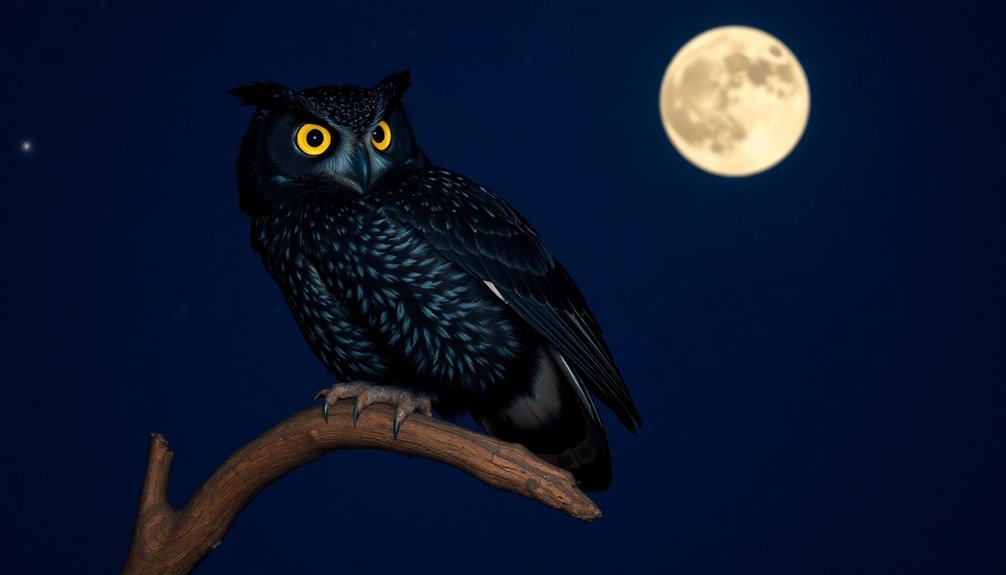
The black owl showcases remarkable physical characteristics and adaptations that enable it to thrive in various environments. Measuring between 35–40 cm in length and weighing 400-535 grams, this bird features a round head without ear tufts, adorned with a sooty black facial disc and distinctive white "eyebrows."
Its plumage includes a striking striped black-and-white breast, sooty black upperparts, and a black-and-white striped collar. You'll notice the yellow-orange beak and reddish-brown eyes, which contribute to its unique appearance. Females tend to be larger than males, averaging 487g compared to 418g. This species is primarily found in tall trees, particularly in forest habitats of North and South America.
Adapted for flight, the black owl possesses large wings that support its lightweight body, allowing for slow flight and even hovering. Its soft feathers facilitate smooth air flow, ensuring silence while flying.
With a heart-shaped facial disk and asymmetrical ear openings, this owl excels at locating sounds, crucial for hunting. Additionally, its long legs and extremely sharp talons enable skillful prey capture, while feather coverage on its feet provides protection from the cold.
These adaptations make the black owl a true master of its environment.
Behavioral Traits and Hunting Skills
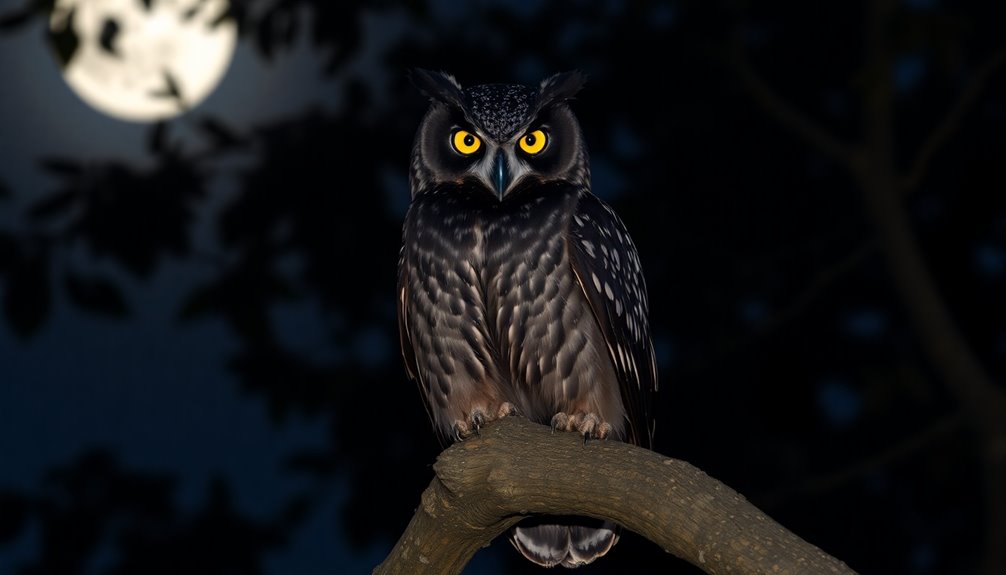
With its impressive physical adaptations, the black owl exhibits fascinating behavioral traits and hunting skills that enhance its survival.
Males are particularly territorial, especially during breeding season. They'll defend a territory ranging from 30 to 50 acres, using vocal and visual displays like hooting and wing clapping to ward off intruders. In fact, they're known to attack other owls of the same species and even humans if they feel threatened.
When it comes to mating, black-and-white owls are monogamous and mate only once a year. Males announce their readiness with a distinct hooting call, complemented by acrobatic flight displays to attract a mate. This intense territorial behavior peaks during breeding season.
As strictly nocturnal creatures, black owls hunt at night, skillfully waiting on perches for their prey. Their keen hearing and exceptional night vision help them locate insects, bats, and rodents in the dark. Additionally, they often nest in old nests of squirrels, hawks, or crows, which provides them with a safe environment for raising their young.
Plus, the unique structure of their primary feathers allows them to fly silently, enhancing their hunting effectiveness. Familiarity with their environment and preferred perches is crucial, enabling them to capitalize on their surroundings for a successful hunt.
Conservation Efforts and Challenges
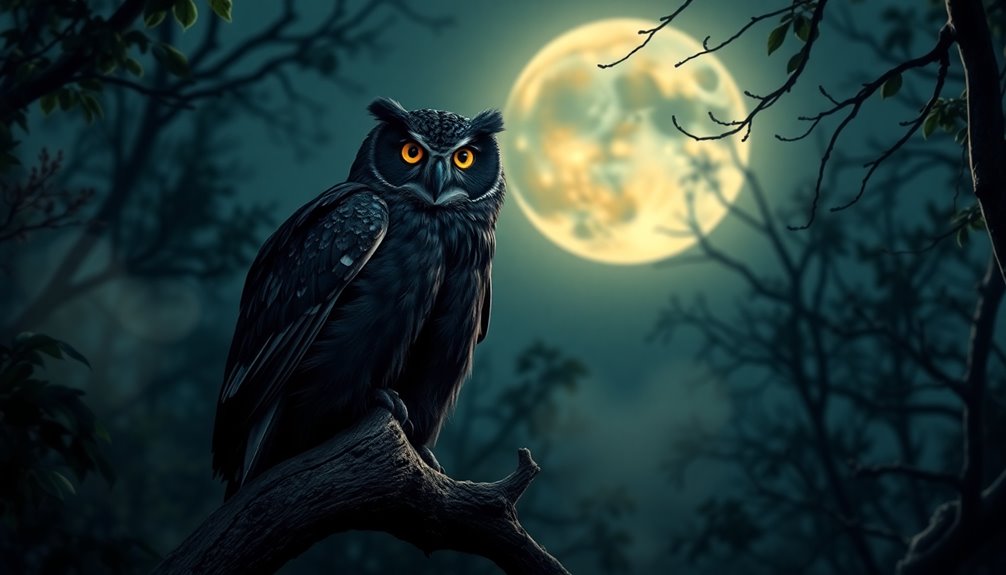
Conservation efforts for black owls face numerous challenges that threaten their survival. One major issue is competition from invasive species like the barred owl, which can lead to a decline in black owl populations. Lethal removal of these invasive species is the only proven method to help protect them, but it requires special permits and trained professionals, complicating the process. Collaborating with land managers and local communities is essential to ensure effective management and habitat restoration.
Additionally, habitat loss due to human activities poses a significant threat. Restoring native habitats and removing invasive vegetation are critical steps in supporting biodiversity. This is particularly important as the black owl primarily inhabits tropical and subtropical forests, which are increasingly under threat.
You must also consider the need for annual monitoring and reporting to assess the success of these conservation strategies. Regulatory complexities and public perception can hinder efforts, so engaging local communities and volunteers is vital for fostering support. Securing funding for restoration projects and balancing development with conservation needs will help create a more stable environment for black owls.
Frequently Asked Questions
What Are Common Myths About Black Owls in Folklore?
In folklore, black owls are often shrouded in mystery and fear. You might hear that their hoots signal impending doom or misfortune, while some cultures believe they're messengers from the spirit world.
Often associated with witchcraft, many think black owls can shapeshift or serve as guides for dark forces.
However, in some traditions, they also symbolize protection and wisdom, embodying the duality of their mystical nature.
How Do Black Owls Differ From Other Owl Species?
Black owls differ from other owl species in several ways.
You'll notice their strikingly striped black-and-white breast and belly, which sets them apart visually.
They're nocturnal and prefer tropical habitats, often nesting in isolated trees.
Unlike many owls, they form monogamous pairs during breeding and exhibit unique courtship behaviors.
Their diet mainly consists of insects, particularly scarab beetles, showcasing their adaptability.
These traits make them distinct within the diverse owl family.
Are Black Owls Considered Good or Bad Omens?
Whether black owls are considered good or bad omens really depends on cultural beliefs and personal perspectives.
In many traditions, they're seen as harbingers of change, signaling transformation and rebirth. However, some view them as symbols of bad luck or death.
You might find that your interpretation shifts based on your experiences and feelings. Embrace the mystery they bring, and trust your intuition to guide your understanding of their significance.
What Habitats Do Black Owls Prefer for Nesting?
When it comes to nesting, you'll find that black owls prefer habitats like tropical and subtropical forests, as well as humid and Atlantic forests.
They thrive in areas with dense canopy and understory, often near water sources. While they usually inhabit lowlands, they can adapt to disturbed areas, including clearings and agricultural lands.
Just look for them in mixed forest landscapes or old, abandoned spaces; they're surprisingly versatile!
Can Black Owls Be Kept as Pets Legally?
You can't legally keep black owls as pets in the U.S. They're protected under the Migratory Bird Treaty Act, and keeping native owls requires special permits that are hard to obtain.
While some states allow non-native owls with permits, you'd still need extensive training and facilities that meet strict standards.
Owls aren't suited for typical home environments, and handling them can be challenging due to their specific care needs and natural behaviors.
Conclusion
In exploring the black owl, you've uncovered its rich symbolism and cultural significance across various regions. Its unique physical traits and impressive hunting skills illustrate why it's considered a mystical messenger of wisdom and protection. However, as you learned, conservation efforts are crucial to ensure these fascinating creatures thrive. By appreciating and advocating for the black owl, you contribute to preserving its legacy for future generations to admire and learn from.


